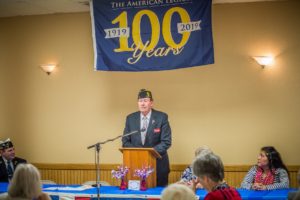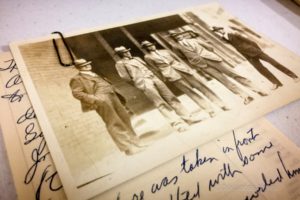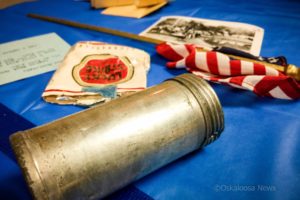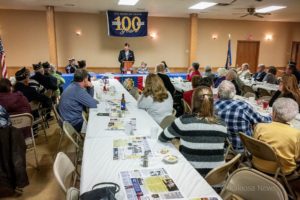Legion Celebrates 100 Years Of History While Looking To The Future
Oskaloosa, Iowa – In the banquet hall of the American Legion Post 34, members and dignitaries gathered to celebrate and honor a century of honor, service, camaraderie, and community service.
Darrin Alderson, 5th District Commander for the American Legion in Iowa lead the evening’s ceremony, sharing that the American Legion is celebrating its 100th year after its formation in Paris, France at the end of World War I in the ‘Paris Caucus.’
Alderson introduced American Legion Past National Commander David Rehbein, who was elected to lead the organization back in 2008 and was Friday night’s special speaker.
“Truly been one of the best mentors that I’ve had in my Legion career so far,” said Alderson of Rehbein. “I truly appreciate everything he’s done for me.”
Rehbein is no stranger to Oskaloosa, making many stops in Oskaloosa back in the ’80s. “We made some good friends down here. Friends we haven’t seen for a long time because they’re gone now.”
“I am glad to see that the Oskaloosa Post has kept this building, kept it as good as it was then, maybe better in some ways, but I really appreciate the opportunity to come back and reminisce a little bit.”
When thinking of things the American Legion has accomplished in the past century, Rehbein thought of the World War I vets who already felt accomplished, but knew that some of their comrades were really going to need help. “There was no veterans hospital system. None whatsoever.”
“People simply went back to their home communities and got healthcare the best they could,” Rehbein added. “There was some severe problems that communities weren’t equipped to handle.”
Blindness, shellshock (PTSD), amputees, spinal injuries, are examples of injuries communities weren’t equipped to handle. “They simply didn’t have the equipment, the abilities,” added Rehbein.

Past National Commander for the American Legion, David Rehbein, was the keynote speaker at the 100th Anniversary celebration held at the Oskaloosa American Legion on Friday evening.
Rehbein believes that those needs were a primary reason the American Legion came into existence. “There were other reasons of course, but it really was their thoughts as they came home. How were they going to take care of their comrades, and how were they going to take care of the families of their comrades who didn’t come home.”
The Second World War started, and Rehbein shared that 70,000 U.S. service members were coming home each month wounded during the summer of 1943. Each one of those returning to their communities, broken and looking for the healthcare they needed. “That’s a big part of what drove the G.I. Bill,” Rehbein remarked, pointing out that 1943 is a year not often looked at as having heavy combat. “But heavy combat was happening in the Pacific.”
The “Serviceman’s Readjustment Act” which is referred to as the G.I. Bill, was passed in 1944, provided a varying range of benefits for G.I.’s returning from the war.
Rehbein then went on to describe the work the American Legion did in helping service members impacted by radiation and Agent Orange. “It was the American Legion that convinced the government of the United States, that when the government does something that hurts one of our servicemen, it’s the government’s responsibility to declare a service-connected injury, and to treat it just like it was a combat injury. So that’s why we have all of the Agent Orange benefits now.”
“It took a lawsuit,” Rehbein said of the 1990 court case. “The American Legion suing the government of the United States. It took the American Legion funding the research study to prove that we could identify where Agent Orange was used.”
Now the American Legion is working to include service members that served during the Cold War, and other times that were considered peacetime, due to the injuries from radiation, and little known and sometimes secret missions. “We’ve lost 1600 to hostile action in places like Greece and that civil war, in the Cold War, and many other places around the world.”
“That legislation is in Congress. We’re going to probably need some help to get that passed because it is going to cost some money, there is no doubt about it, but it’s money that needs to be spent. There are benefits that need to be provided.”

Scrapbooks made by the Oskaloosa American Legion over time were on display, and people could see a glimpse into the Post’s past.
“It also opens Legion membership eligibility to all of those folks,” Rehbein added.
Rehbein then took the crowd on a tour back in time, to when the American Legion was getting its start in Iowa.
Dr. Mathew Tinley was instrumental in the Iowa District of the American Legion and was the first department commander. “He went overseas with the 168th Infantry Regiment. He went into the military in 1894 as a private, but unlike most of the rest of us, he came out of that military quite a number of years later as a lieutenant general in command of the 34th Infantry Division,” Rehbein shared.
“He was a very beloved commander of the 168th Infantry when he came home,” shared Rehbein. “He was made temporary chairman as the Legion was forming.”
Tinley helped to lead the formation of 182 American Legion Posts, which then lead to the formation of 352 Posts. “By the time he finished his year as commander at that second convention, there were 542 Posts in Iowa,” explained Rehbein.
John McVicker was also recognized for his efforts in making the Legion in Iowa what it is today. McVicker served as secretary, starting in 1919.
McVicker enlisted to serve in World War I when he was 58 years old, and had already been the Mayor of Des Moines three times.
McVicker oversaw the chartering of the 542 posts in less than 500 days. “That’s a blizzard of paperwork,” Rehbein said.
“That’s the quality of the people that Iowa in those first years put forth,” added Rehbein. “They came home with a sense of accomplishment. They came home knowing that they could accomplish more. I don’t care what the challenge is in front of you. If you believe that you can meet that challenge, you can.”
The ceremony then turned to the opening of the time capsule that had been sealed since the late 1940s, which included a membership roster from 1948-49, and had over 800 members.
Also included were newspaper articles, photographs of the Oskaloosa Legion Band, photos of the previous post, and the post’s namesake Harry L. Anderson, who was the first Mahaska County resident killed in World War I.

A time capsule from the late 1940’s was opened on Friday night. Inside the capsule was a scroll with legion member names, a 48 star American Flag, a used pack of Lucky Strike cigarettes, photos, post cards and newspaper clippings.
Darrin Alderson, Oskaloosa resident and 5th District Commander, has been a member of the American Legion for going on seven years. During that time, Alderson has been a post commander, district commander, and holds a national commission.
Alderson said that people like Rehbein have been instrumental in helping him become more involved.
One of those things that motivated Alderson to volunteer so much for the American Legion journey is the camaraderie he gets to have with fellow veterans. “You don’t think much about camaraderie until you don’t have that camaraderie after you get out of the service.”
The American Legion was a place where Alderson could find that camaraderie, and it helped him to gather up his personal life into focus. “Now you feel like you’ve got a sense of purpose.”
Being able to spend that time with others “who have been there, done that”, as Alderson explains, can then help you with your other issues. “I’m pretty sure when I first got out that I had some issues with PTSD, but I wouldn’t go see anybody because I was too bullheaded. That’s what the Legion is about. We take care of each other.”
That healing that takes place by being with individuals who have served is what makes the local level of the American Legion so special. On the national level, the Legion plays a watchdog role to protect and fight for veterans rights. “We push for oversight of the VA System, and then we are also pushing for new programs to help out,” added Alderson.
An example of the Legion helping veterans took place during the most recent government shutdown when the Coast Guard wasn’t being paid during that time; the Legion dipped into their emergency fund to help those service members meet their financial obligations. The Legion gave out just short of one million dollars during that time.
“That’s the impact that the Legion has on a national level. It wouldn’t happen at the national level if it wasn’t for the post level making it happen,” added Alderson.
Looking forward 50 years and 100 years, Alderson hopes that the American Legion is still in existence helping veterans and their communities while being “Just as strong as we are today.”











